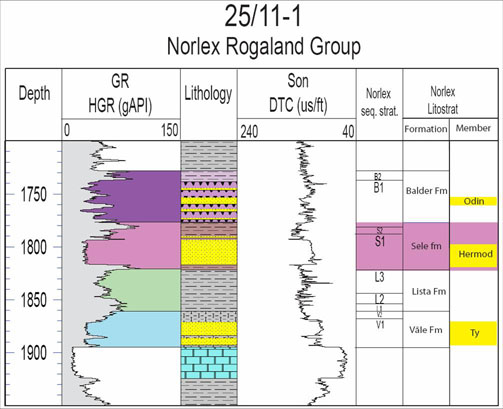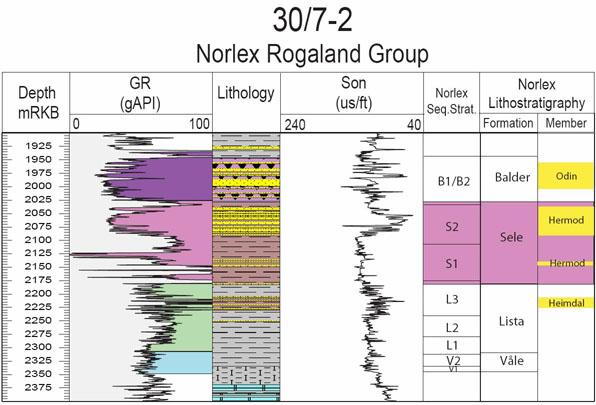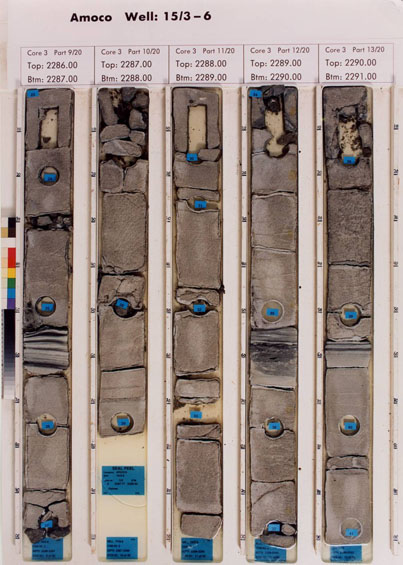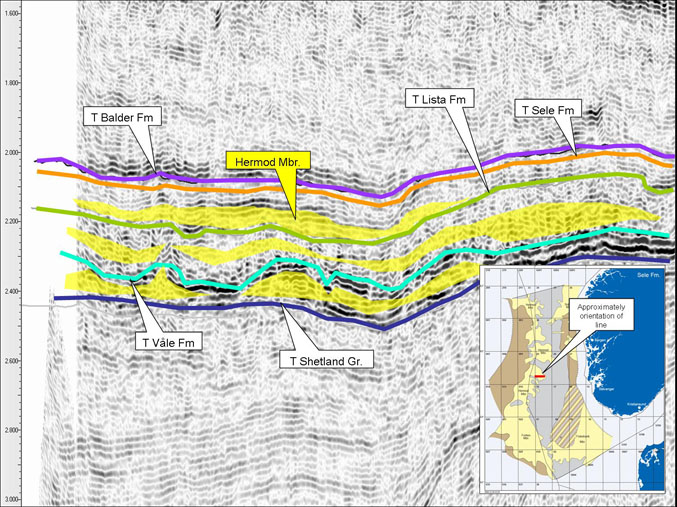Hermod Member
Rogaland Group, Sele Formation
Unit definition
The Hermod Member is attributed to the intra Sele Formation sandstones encountered in
subarea NW in Figs. 12 and 13, mainly in the Viking Graben and the East Shetland basin.
Name
The Hermod Member is renamed from the Hermod Formation defined by Hardt et al. (1989)
in Isaksen and Tonstad (1989). The Hermod Member is age equivalent to the marginal
to slope marine sandstones of the Dornoch member of the UK sector.
Derivatio nominis
The Hermod member is named after the Norse god Hermod, a son of Odin (Hardt et al.,
in Isaksen & Tonstad, 1989).
Type well
Norwegian well
25/2-6 (Fig. 112). Depth
2221-2361 m. Coordinates N 59°45'33.55", E 02°33'05.96". No cores. Defined by Hardt
et al (1989).

Fig. 112. Well 25/2-6 Composite log Rogaland Group. Stratigraphic position of the
Hermod Member is outlined in stratigraphic column to the right.
|
Reference wells
UK well 10/1-1A. Depth 2126-2212 mRKB. Coordinates N 59°50'10.51", E 02°00'33.60".
No cores. Defined by Hardt et al (1989).
Norwegian well 25/11-1
(new, Fig. 113). Depth 1790-1818 mRKB. Coordinates N
59°10'53.00", E 02°24'49.00". No cores.
Norwegian well 30/7-2
(new, Fig. 114). Depths 2039-2095 and 2123-2147 m. Coordinates
N 60°29'26.06", E 02°01'40.85". No cores.

Fig. 113. Well 25/11-1 Composite log Rogaland Group. Stratigraphic position of the
Hermod Member is outlined in stratigraphic column to the right.
|

Fig. 114. Well 30/7-2 Composite log Rogaland Group. Stratigraphic position of the
Hermod Member is outlined in stratigraphic column to the right.
|
Composition
The Hermod Member consists of well-sorted, very fine- to medium-grained sandstones,
interbedded with claystones. Internally the sandstones sometimes have thin interbeds
of fissile mudstone. The top and base of the Hermod Member are restricted to the
diagnostic Sele Formation mudstones above and below.
Sandstone intrusions are frequently found associated with the upper boundary of
sandstones bodies, often with an abundance of angular and tabular mudstone clasts.
A core example from Norwegian well 15/3-6 is shown in Fig. 115, displaying clean,
massive beds of sandstone with interbeds of heterolithics, probably representing a
series of stacked high density turbidite beds.

Fig. 115. Core photo example from the Hermod Member. Sediments consist of clean,
massive sandstones with water escape structures and heterolithic interbeds. Well
drilled by Amoco. Photo from NPD Fact Pages at http://www.npd.no.
|
Wireline log characterization
The sandstones of the Hermod Member often display massive blocky zones of low
gamma-ray readings with distinct and abrupt transitions against the higher gamma-ray
and low velocity of the encasing shales.
Lower boundary
The lower boundary of the Hermod Member is identified by an upwards transition from
the shales of the Sele or the Lista
Formation below. The log response is
characterised by a sharp upwards change from high gamma-ray readings and low velocity
in the shales to low gamma-ray readings and high velocity in the Hermod sandstone.
Upper boundary
The Hermod Member is overlain by the Sele Formation, and the
boundary is an abrupt
change from sandstones to dark shales. The gamma-ray response changes upwards from
low readings in the sandstones to significantly higher readings in the Sele Formation
above. The sonic changes from high to low readings.
Thickness
The Hermod Member can be more than 100 m thick (101 m in well 25/1-1 and 172 m in
well 25/2-1), but is mostly in the order of a few meters to a few tens of meters.
Seismic characterization
The Hermod Member often exhibits a high acoustic contrast when low velocity Sele
Formation shales are found above and below. In such cases a high amplitude response
is often seen.
The external geometry of the Hemod Member can be mounded, lenticular or trough like
channel fills, sometimes associated with seismic scale injectites.
A seismic example from block 25/10 is shown in Fig. 116, displaying the Hermod Member
as the uppermost sandstone unit.

Fig. 116. Seismic cross section through southern parts of block 25/10. Inferred
presence of Hermod sandstones is outlined.
|
Age
Latest Paleocene-Earliest Eocene (Late Thanetian-Earliest Ypresian).
Biostratigraphy
Being contained in the Sele Formation, the age of the Hermod Member is
bounded by
biostratigraphy and age assignments for the Sele Formation. See description for the
Sele Formation in Subchapter 6.1.
Correlation and subdivision
Based on the diagnostic Apectodinium spp. Acme biomarker internally in the
Sele
Formation, the Hermod Member is subdivided into Hermod S1, which lies below the
biomarker, and correlates to Skadan and the Teal Members in the UK Viking Graben, and
the Hermod S2, which lies above the biomarker, and correlates to what is called the
Hermod Member in the UK sector.
Geographic distribution
The Hermod Member is mainly restricted to the Viking Graben, and pinches out distally
to the east. Sometimes it stretches onto the western flank of the Utsira High (Fig.
102).
Occurrences of member tops in wells
Depositional environment
The Hermod sandstones are related to submarine-fan systems where the most distal
parts are interpreted as lobe deposits. The sands were shed eastwards from the shelf
areas of the East Shetland Platform (Conort 1986). The feeder systems are sometimes
discrete channels that go into radiate fans. In other cases the Hermod sand system
consists of channel/lobe complexes of more amalgamated lobes and channels.
Discoveries in Norway with the Hermod Member as hydrocarbons reservoir
- Balder Field, part of the reservoir. Oil discovery.
- Enoch Field, oil discovery (UK/Norway cross border Field)
- Alvheim Field, part of the reservoir. Oil discovery.
- Ringhorne Field, part of the reservoir. Oil discovery.






